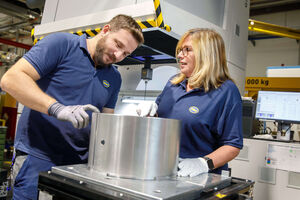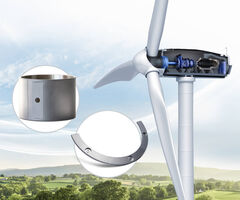- Company
- Industries
- Product areas
- Innovation
- Jobs and Career
- Apprenticeship
- News
In many industrial applications, roller bearings are considered the proven standard. But what can be done when they reach their limits under extreme conditions such as high speeds, shock loads or limited installation space? In such cases, it is worth considering hydrodynamic bearings, as they offer several advantages over roller bearings.
Switching from roller bearings to hydrodynamic bearings is also easier than you might think. This is especially true when the switch is made systematically and with the support of experienced partners. In this article, you will learn what
You can also find more detailed information on the differences and advantages of hydrodynamic bearings and roller bearings in our basic article.
![[Translate to English:] Blaues Icon zerbrochene Klammer auf weißem Hintergrund](/fileadmin/_processed_/0/7/csm_Weakness_571aec6863.png)
Rolling bearings are the first choice in many machine designs. They are inexpensive, standardized and widely used. However, their performance can quickly be limited, especially in harsh operating environments.
A detailed comparison of hydrodynamic bearings and roller bearings shows where conventional roller bearings are at a disadvantage and what specific potential advantages hydrodynamic bearings can offer over roller bearings.
Typical weak points of roller bearings:
At very high speeds, friction and heat generation can become a problem due to rolling elements and cages. Their maximum speeds are limited by their design.
A practical example: Compressors and gearboxes are often subject to high loads and temperatures. These are ideal conditions for the use of robust hydrodynamic bearing solutions. In this article, we show how these can be successfully integrated: Successful use of hydrodynamic bearings in compressors
A direct comparison between hydrodynamic bearings and roller bearings shows that hydrodynamic bearings are the more robust, durable and efficient solution in many applications. This is particularly true in situations where roller bearings reach their physical or operational limits.
The following advantages of hydrodynamic bearings over roller bearings are particularly relevant in practice:
Hydrodynamic bearing have the advantage over roller bearings in that they transfer loads over a large area. Roller bearings, on the other hand, transmit loads at discrete points via balls or rollers. This means that hydrodynamic bearing can absorb significantly higher forces in the same installation space. This is a decisive advantage, especially for highly loaded bearing points.

Direct contact between the bearing and the housing allows hydrodynamic bearings to dissipate heat more efficiently. Depending on the application, special bearing materials from Miba can also be used to improve heat dissipation.

Compared to roller bearings, hydrodynamic bearings are significantly more robust against external influences such as particles, moisture or vibrations. In harsh environments, this is a decisive advantage that contributes to operational reliability.

While roller bearings are standardized, hydrodynamic bearings can be individually adapted to the requirements of the respective application in terms of shape, material and design. This enables both more compact assemblies and additional functional benefits, for example through integrated damping elements.

Switching from a rolling bearing to a hydrodynamic bearing does not necessarily mean a complete redesign. In most cases, only minimal adjustments are required in terms of design.
Hydrodynamic bearings can often use the necessary oil that is already available in the immediate surroundings. Initial trials or qualification of the technology can therefore usually be carried out in the existing system with minimal adjustments.
Those who want to take advantage of the benefits of hydrodynamic bearings over roller bearings can significantly increase the service life and reliability of their application through a systematic switch. At Miba, we support our customers in this process as experienced engineering partners.
First, the existing bearing location is examined under real operating conditions. Typical questions:
The general conditions are used to check whether and how the bearing location in question can be designed with a hydrodynamic bearing. The factors mentioned above are already taken into account here.
Tools such as the
are used in this phase for an initial statement.
The material, geometry, and bearing type (e.g., radial, axial, or combination bearing) are defined according to the requirements.
In consultation with the design team, the existing assembly is adjusted if necessary. In many cases, only minimal adjustments to the system are required.
Once the design phase is complete, the first prototypes are manufactured and validated in real-world conditions. Miba provides support throughout all stages of the process up to series production approval, including design, manufacturing, and after-sales support. This allows the advantages of hydrodynamic bearing over rolling bearings to be translated into specific product improvements. Read more about this in our blog article: Bearing solutions – from the initial idea to after-sales service

A particularly impressive example of the successful switch to hydrodynamic bearing can be found in wind energy in main gearboxes of wind turbines, especially in planetary stages of higher power classes.
With minimal adjustments, initial tests and qualification of the technology were carried out in existing systems. This demonstrated that the limits of planetary gearboxes could be pushed with little effort and that the advantages of hydrodynamic bearings over roller bearings could be exploited:
These findings were taken into account during the design phase of the next evolutionary stage of planetary gearboxes and the advantages of hydrodynamic bearings were fully exploited.
This experience from the wind power industry can be transferred as a blueprint to many other industries.
The advantages of hydrodynamic bearings over roller bearings are particularly evident when standard solutions reach their limits:
With a structured conversion process, hydrodynamic bearing solutions can be integrated into existing or new systems in an economical, safe and sustainable manner. A final comparison once again highlights the differences between hydrodynamic bearings and roller bearings.
| Roller Bearings | Hydrodynamic Bearings | |
| Load Capacity | Point load | Carrying higher load capacity |
| Rotational speed | Constructively limited | High due to hydrodynamic principle |
| Dirt and vibration resistance | Low | High |
| Space optimization | Restricted | Low installation space required |
| Adaptability | Mostly standard solutions | Individual designs |
| Service life | Limited by material fatigue | Unlimited in hydrodynamic operation |
Miba supports you throughout the transition, from technical analysis to customized hydrodynamic bearing solutions. Get advice now!